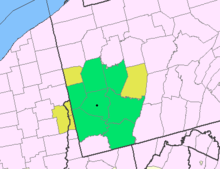Marcellus Formation
[10] Fresh exposures of the pyriteiferous shale may develop the secondary mineralization of orange limonite (FeO(OH)·nH2O), and the pale yellow efflorescence or bloom of sulfur, associated with acid rock drainage.
[16] Measured total organic content of the Marcellus ranges from less than 1% in eastern New York, to over 11% in the central part of the state,[17][18] and the shale may contain enough carbon to support combustion.
[21] To the west the formation may produce liquid petroleum; further north heating during deeper burial more than 240 million years ago cracked this oil into gas.
[25] Below Lake Erie, it can be found crossing the border into Canada, where it stretches between Port Stanley and Long Point to St. Thomas in southern Ontario.
[29] The New York outcrops, and others further south in Pennsylvania and New Jersey, were extensively excavated in the early 19th century, sometimes at great expense, in the false hope of finding minable coal seams.
[29] In Perry County, Pennsylvania along the Juniata River the false coal beds become up to .3 m (1 ft) thick, but they did not produce a valuable fuel, despite the considerable effort expended to mine it from the surrounding hills.
[31][32] Close proximity to the surface of Marcellus bedrock south of the New York outcrops makes an east–west band running through the city of Syracuse[14] a high-risk area for radon as an indoor air pollutant.
[25] Upturned beds are exposed in sections of the folded Ridge-and-Valley Appalachians,[23] including exposures on the flanks and axis of the Broad Top Synclinorium in south central Pennsylvania.
[30] Nearby, in the Lehigh Gap area of Pennsylvania, the Marcellus is extensively faulted,[36] and the beds are steeply overturned, with a reverse dip angle of up to 40° south.
[38] The Marcellus is easily eroded, and is also found underlying low areas between some Appalachian ridges, forming linear valleys of moderate relief.
[47][48] In West Virginia, the Marcellus may be separated from the brown shales of the Mahantango by occasional sandstone beds and concretions,[49] or it may lie directly below the younger Late Devonian Harrel Formation (or its lateral equivalents) because of a disconformity,[50] which represents a gap in the geological record due to a period of erosion or non-deposition.
[58] In eastern West Virginia the Marcellus overlies the Onesquethaw Group, consisting of the dark gray or green, calcitic, mostly nonfissil Needmore Shale, which grades westward into the Huntersville Chert.
[62] Tioga metabentonite or K-bentonite–stratigraphic unit about .6 m (2 ft) thick that consists of several discrete, relatively thin volcanic ash falls–is also included at the base of the Marcellus in eastern Pennsylvania.
[69] From Virginia to New York the Tioga is widely distributed, running across the central and northern parts of the Appalachian basin,[70] an areal extent exceeding 265,000 km2 (102,000 sq mi).
[69] The Tioga may appear in the formation as a gray, brown, black, or olive bed, or parting,[69] consisting of coarse crystal tuff or tuffaceous shale,[65] thinly laminated, with sand-sized mica flakes.
[18] A regional unconformity appears in western New York, as the Union Springs lenses in and out,[18] and then reappears in northwest Pennsylvania and northeast Ohio between the Onondaga and Cherry Valley.
[94] Life on land also enters the fossil record in the Marcellus, with the trunks of branchless conifer trees that floated out to sea to be preserved in the black shale.
[103] This stratigraphic interval also provides an excellent example of incursion epiboles, which are sudden appearances and disappearances of fossil taxa in relatively thin sections of the rock unit.
[106] Relative age dating of the Marcellus places its formation in the Cazenovia subdivision of the Givetian faunal stage, or 391.9 to 383.7 million years ago (Ma).
[122] Named members of the Marcellus reflect two composite depositional sequences,[123] with a general coarsening upward cycle that continues into the base of the overlying Mahantango Formation.
[113] The shale contains largely untapped natural gas reserves, and its proximity to the high-demand markets along the East Coast of the United States makes it an attractive target for energy development and export.
[131] Ore found interbedded in the black slaty shale contained a relatively high proportion of carbon which was burned in the furnace, and sulfur, which produced a usable but "red-short" iron.
After being heated in a kiln and finely ground, it was mixed with linseed oil, and used to paint exterior wood on barns, covered bridges, and railroad cars.
[30] In addition to the bog iron, at several sloped locations in eastern Pennsylvania brown hematite was found lying on the Marcellus bedrock buried beneath the soil.
[30] Iron rich "ferruginous waters" emanating from chalybeate springs near the base of the Marcellus in Bedford, Pennsylvania were believed to have healing powers by Native Americans.
[138] In the 19th century, this shale was used for walkways and roadways,[20] and was considered superior "road metal" because the fine grained fragments packed together tightly, yet drained well after a rain.
[51] Scientists believe that adsorption would allow sequestration at shallower depths than absorption in deep saline formations, which must be at least 800 m (2,600 ft) below the surface to maintain liquid CO2 in a supercritical state.
Exposures from cut and fill road construction in Virginia and Pennsylvania have resulted in localized acid rock drainage due to oxidation of the pyrite inclusions.
[139] The newly exposed shale on the cut face weathers rapidly, allowing air and water into the unexcavated rock, resulting in acidic surface runoff after precipitation events.
[138] Limestone, which is used to neutralize the acid drainage, can actually exacerbate the expansion problem by promoting sulfate–sulfate reactions that form the minerals thaumasite and ettringite, which have even higher molar volumes.











